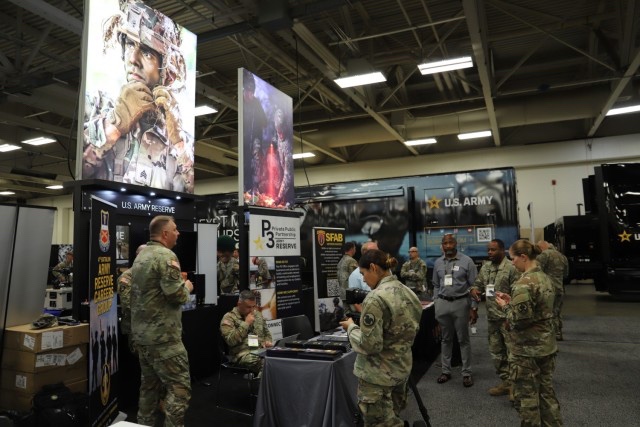
FORT LIBERTY, N.C. — Achieving the Army of 2030 and designing the Army of 2040 will require transformative vision, thoughtful leadership and sound investment, according to speakers at the July 26-27 Association of the U.S. Army Warfighter Summit and Exposition in Fayetteville, N.C.
Senior Army leaders from nearby Fort Liberty, N.C., across the U.S. Army and industry provided details and discussions on “America’s Army: Ready for Today, Modernizing for 2030 and Beyond.” The theme echoes the Army’s three priorities: people, readiness and modernization. This is the second year AUSA hosted the Warfighter Summit.
More than 800 attendees heard about the future of Soldier training and Army doctrine, Army modernization over the next seven to 17 years, the XVIII Airborne Corps’ role as America’s Contingency Force, the role of Army Security Force Assistance Brigades in 2030, insights from recent conflicts in Europe, training units at the Army’s Combat Training Centers and irregular war campaigning for 2030 with U.S. Army Special Operations Command.
The summit’s primary focus is the Soldier and the defense industry professionals who support the Army warfighter. The summit linked Fort Liberty Soldiers and senior leaders with industry partners to increase understanding of the Army’s emerging requirements and strengthen the partnership between Fort Liberty, AUSA and the surrounding community. Over 65 exhibitors highlighted organizations that provide Soldiers with educational and employment opportunities, military equipment and high-tech devices. The audience included active-duty Army, U.S. Army National Guard and U.S. Army Reserve Soldiers.
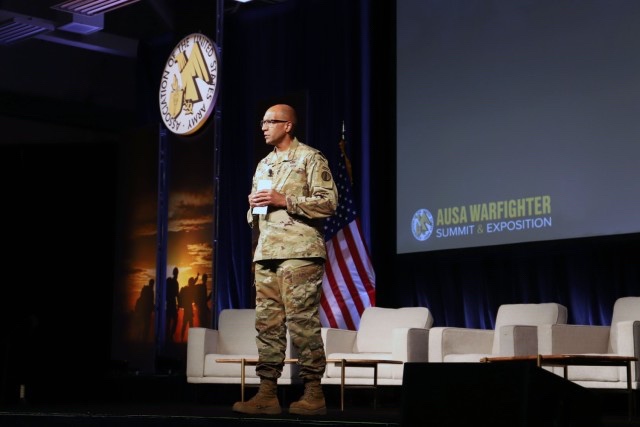
In addition to civilian, commercial vendors, the Warfighter Summit featured U.S. Army equipment, including: the Joint Lightweight Tactical Vehicle, the Infantry Squad Vehicle, the Polaris MRZR-D4, the Ground Mobility Vehicle, the MH-6M Light Assault Helicopter and the AH-64 Apache Attack Helicopter.
The Army has been consistent and persistent in pursuing modernization initiatives to deliver the Army of 2030 and design the Army of 2040. It is committed to six modernization portfolios: long-range precision fires, next generation combat vehicle, future vertical lift, the network, air and missile defense, and Solider lethality.
Delivering the Army of 2030 and designing the Army of 2040 are priorities of Forces Command, Army Futures Command and Army Training and Doctrine Command. All three commands — as well as the U.S. Army Special Operations Command — were represented at the two-day professional forum.
The Warfighter Summit opened July 26 with a keynote presentation by Gen. Gary Brito, commanding general of Training and Doctrine Command.
“The Army’s most valuable asset is its people,” said Gen. Gary Brito, commanding general of U.S. Army Training and Doctrine Command. “This is a big, total-team effort and we will succeed at this,” Brito said. “To deliver the Army of 2030 and get ready for 2040, we are turning today’s recruiting challenge into an opportunity and continuing to innovate our talent management approaches.”
“From an acquisition lens, 2030 is really tomorrow,” he said.
Brito said the Army is at an “inflection point right now,” facing changes like those it made 50 years ago at the start of the all-volunteer force and the creation of TRADOC and FORSCOM.
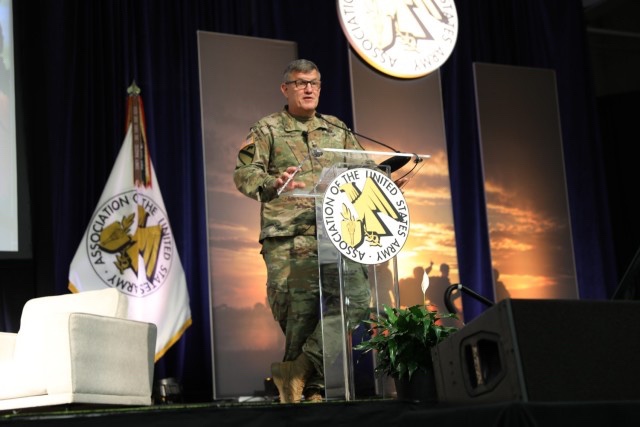
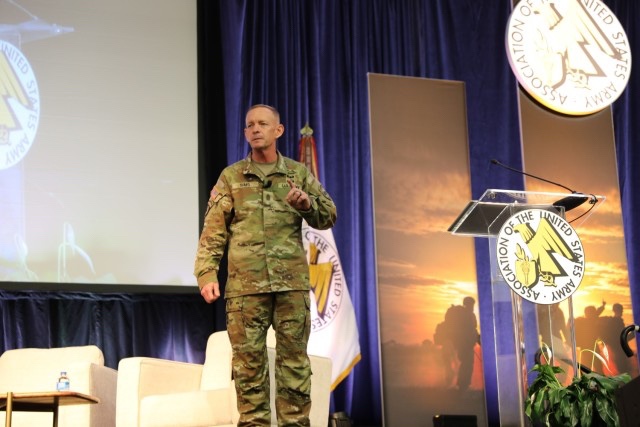
“I think from a technology perspective, this is probably the most disruptive period of time since World War II,” said Gen. James Rainey, Army Futures Command commanding general.
“War remains a contest of wills between human beings: people,” Rainey said. “You have to be able to impose your will. You have to be willing to pay the cost. Because of that, we are going to need the U.S. Army to be able to dominate the land domain … anywhere against any body as part of a joint force with partners and allies. To do that, we need people ”
FORSCOM Command Sgt. Maj. Todd Sims celebrated his 53rd birthday with a keynote speech at the AUSA Summit.
“Kids these days. I’ve seen you on the job … In training, on deployments and with your teams. I know what you are all about. When I travel around the force, I witness levels of insight and resourcefulness among junior Soldiers.”
“Kids today are smart,” Sims said. “They have unfettered access to all the world’s information. They know how to navigate and apply it in useful ways. Smart young Soldiers have always been one of the Army’s biggest competitive advantages.”
Sims also spoke about “Training the Force of 2030” — to include the Army’s premier Combat Training Centers: the National Training Center at Fort Irwin, California and the Joint Readiness Training Center at Fort Johnson, Lousiana.
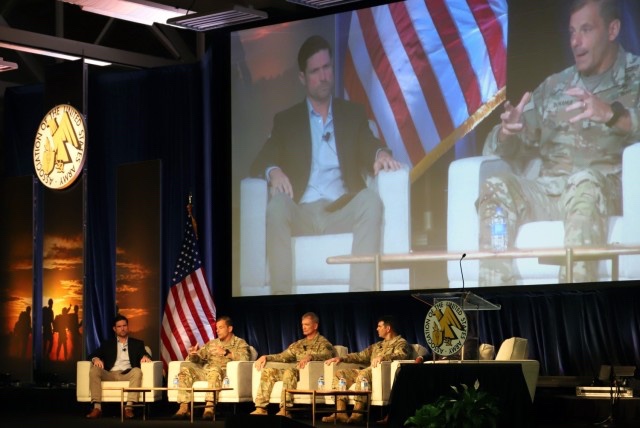
Fort Liberty leaders emphasized the Army post’s role as America’s Contingency Force during a discussion by Lt. Gen. Christopher Donahue, commanding general of the XVIII Airborne Corps and Fort Liberty, and by XVIII Airborne Corps’ Command Sgt. Maj. Thomas J. “T.J” Holland.
“The XVIII Airborne Corps is really FORSCOM’s and the Army’s contribution to the contingency force,” Donahue said. “It’s made up of four separate divisions, but the ‘critical sauce’ is those separate brigades. That forms the Army’s contribution to any time we have to go anywhere to compete against any adversary across the globe. Fort Liberty is the strategic platform for the U.S. Army. It has every contingency Special Operations Forces; every contingency force on the larger capability is here.”
U.S. Army Special Operations Command’s deputy commanding general, Maj. Gen. Patrick Roberson, also highlighted Fort Liberty’s vital role in irregular warfare.
“USASOC provides all of the Army Special Operations Forces to the Joint Force,” Roberson said. Over the last 20 years, we were focused on irregular warfare campaigning throughout the world.”
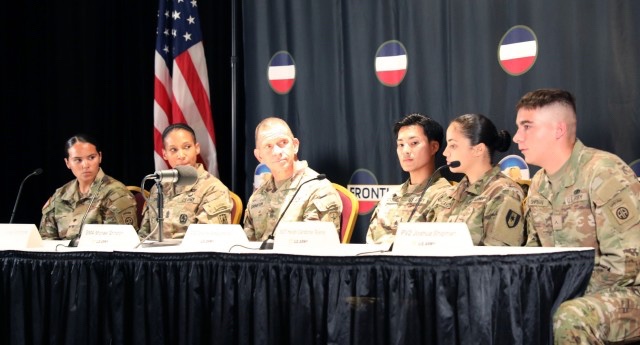
Maj. Gen. Donn Hill, commanding general of the Army Security Force Assistance Command, also based at Fort Liberty, said “The adviser teams of today are designed to advise at the tactical level. We were all about counterinsurgency and stability operations, but the world has changed. The Army is changing.”
“We’re in 30 countries on any given day,” Hill said about the six security force assistance brigades. Additionally, the teams are on the ground persistently, spending six months with allied partner armies before they are replaced by another team of Soldiers.
Lt. Gen. Kevin Vereen, deputy Army chief of staff for installations, G-9, at the Pentagon discussed employment opportunities for Soldiers and spouses. “The G-9 enables readiness through our quality-of-life plans, programs and policies that help the Army recruit, train, fight and win,” he said.
A highlight of the Warfighter Summit was a discussion by Sergeant Major of the Army Michael Grinston, who spoke about the key leadership role of the U.S. Army’s Non-Commissioned Officer Corps. He also conducted a panel discussion with Fort Liberty NCOs and Soldiers about the 75th anniversary of the integration of the U.S. Armed Forces.
By FORSCOM Public Affairs


Fort liberty. Still want to call it Bragg
Me too
I understand the rationale for the name change, and don’t disagree with it, and I appreciate that this name was suggested by a Gold Star Mom – but I still think it would have been better to name it after Gavin, Ridgeway, or Yarborough.
Also, when I hear the name, those stupid car commercial ads spring to mind unfortunately…
I hear/read “Fort Liberty” and think “Fort Phoned-It-In”
The name instills in me the image of a sister-post to “Fort Courage” in the Old West
Will take a generation to really sink in, hopefully everyone’s understanding about it slipping.
“To deliver the Army of 2030 and get ready for 2040, we are turning today’s recruiting challenge into an opportunity and continuing to innovate our talent management approaches.”
Sorry, but this sounds like it was cribbed from a Subaru commercial.
Let’s speak plainly. The recruitment pool has never been so challenging and filled with unqualified people. Many of the qualified people we traditionally recruit from are not interested in signing up. We are lowering standards and using waivers to make the number. You tell me what that future force looks like, because given the threats we face, it doesn’t sound good.
We have a good core of people who have carried the load for the past 20 years of conflict, yet some of them are underutilized or being pushed aside. We continue to put SOF under a high deployment cadence, in a pool of shrinking qualified candidates. Where that leaves us, I have no idea- and I do t believe anyone else does either. But the answer isn’t a few trite, banal statements that sound like they came from a fortune cookie.